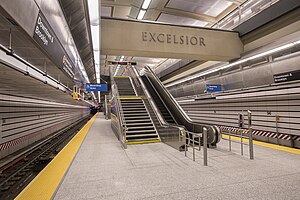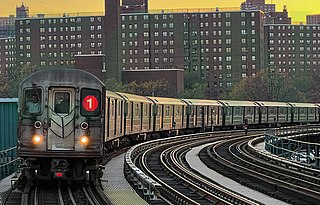
The New York City Subway is a rapid transit system in the New York City boroughs of Manhattan, Brooklyn, Queens, and the Bronx. It is owned by the government of New York City and leased to the New York City Transit Authority, an affiliate agency of the state-run Metropolitan Transportation Authority (MTA). Opened on October 27, 1904, the New York City Subway is one of the world's oldest public transit systems, one of the most-used, and the one with the most stations, with 472 stations in operation.
The Second Avenue Subway is a New York City Subway line that runs under Second Avenue on the East Side of Manhattan. The first phase of this new line, with three new stations on Manhattan's Upper East Side, opened on January 1, 2017. The full Second Avenue Line will be built in three more phases to eventually connect Harlem–125th Street in East Harlem to Hanover Square in Lower Manhattan. The proposed full line would be 8.5 miles (13.7 km) and 16 stations long, serve a projected 560,000 daily riders, and cost more than $17 billion.

The 125th Street station is an express station on the IRT Lexington Avenue Line of the New York City Subway. Located at Lexington Avenue and East 125th Street in the East Harlem neighborhood of Manhattan, it is served by the 4 and 6 trains at all times, the 5 train at all times except late nights, and the <6> train during weekdays in peak direction. The station contains four tracks and two island platforms split across two levels. The upper level is used by northbound trains to the Bronx, while the lower level is used by southbound trains to Lower Manhattan and Brooklyn.
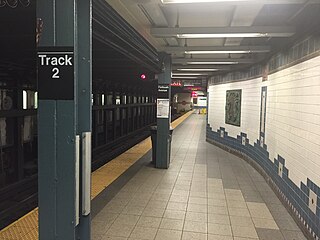
The Flatbush Avenue–Brooklyn College station is the southern terminal station on the IRT Nostrand Avenue Line of the New York City Subway. It is located at the intersection of Flatbush and Nostrand Avenues in Flatbush, Brooklyn, locally called "The Junction". The station is served by the 2 train at all times and the 5 train on weekdays. It is also the closest subway station to Brooklyn College and Midwood High School.
The IRT Broadway–Seventh Avenue Line is a New York City Subway line. It is one of several lines that serves the A Division, stretching from South Ferry in Lower Manhattan north to Van Cortlandt Park–242nd Street in Riverdale, Bronx. The Brooklyn Branch, known as the Wall and William Streets Branch during construction, from the main line at Chambers Street southeast through the Clark Street Tunnel to Borough Hall in Downtown Brooklyn, is also part of the Broadway–Seventh Avenue Line. The IRT Broadway–Seventh Avenue Line is the only line to have elevated stations in Manhattan, with two short stretches of elevated track at 125th Street and between Dyckman and 225th Streets.
The IRT Lexington Avenue Line is one of the lines of the A Division of the New York City Subway, stretching from Lower Manhattan north to 125th Street in East Harlem. The line is served by the 4, 5, 6, and <6> trains.

The Second Avenue station is a station on the IND Sixth Avenue Line of the New York City Subway, located at the intersection of Second Avenue and Houston Street on the border between the East Village and the Lower East Side, in Manhattan. It is served by the F train at all times and the <F> train during rush hours in the peak direction.
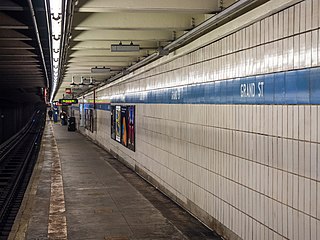
The Grand Street station is an express station on the IND Sixth Avenue Line of the New York City Subway. Located at the intersection of Grand Street and Chrystie Street at the border of Chinatown and the Lower East Side, it is served by the D train at all times and the B train on weekdays.

The 96th Street station is a local station on the IND Eighth Avenue Line of the New York City Subway. Located at West 96th Street and Central Park West on the Upper West Side, it is served by the B on weekdays, the C train at all times except nights, and the A train during late nights only.

The 23rd Street station is a local station on the IND Sixth Avenue Line of the New York City Subway, located at the intersection of 23rd Street and Sixth Avenue in Manhattan. It is served by the F train at all times, the M train during weekdays, and by the <F> train during rush hours in the peak direction. This station and 14th Street are the only two local stations on the Sixth Avenue Line.
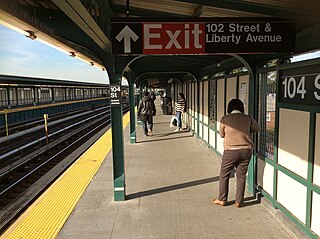
The 104th Street station is a station on the IND Fulton Street Line of the New York City Subway, located on Liberty Avenue at 104th Street in Ozone Park, Queens. The station is served by the Lefferts Boulevard branch of the A train at all times.

The Lexington Avenue–63rd Street station is a New York City Subway station in Lenox Hill, Manhattan, shared by the IND and BMT 63rd Street Lines. Located at the intersection of Lexington Avenue and 63rd Street, it is served by the F and Q trains at all times; <F> trains during rush hours in the peak direction; limited rush hour N trains; and one A.M. rush hour R train in the northbound direction only.
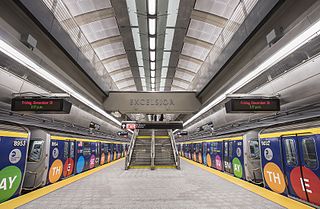
The 86th Street station is a station on the first phase of the Second Avenue Line of the New York City Subway. Located at the intersection of Second Avenue and 86th Street, in the Yorkville section of the Upper East Side in Manhattan, it opened on January 1, 2017. The station is served by the Q train at all times, limited rush hour N trains, and one northbound A.M. rush hour R train. There are two tracks and an island platform.

The 72nd Street station is a station on the first phase of the Second Avenue Line of the New York City Subway. Located at the intersection of Second Avenue and 72nd Street, in the Lenox Hill section of the Upper East Side in Manhattan, it opened on January 1, 2017. The station is served by the Q train at all times, limited rush hour N trains, and one northbound A.M. rush hour R train.

Metropolitan Transportation: A Program for Action, also known as simply the Program for Action, the Grand Design, or the New Routes Program, was a proposal in the mid-1960s for a large expansion of mass transit in New York City, created under then-Mayor John Lindsay. Originally published on February 29, 1968, the Program for Action was one of the most ambitious expansion plans in the history of the New York City Subway. The plan called for 50 miles (80 km) of tracks to be constructed, and more than 80% of the new trackage was to be built in the borough of Queens. The $2.9 billion plan also called for improvements to other modes of mass transit, such as the present-day Long Island Rail Road and Metro-North Railroad commuter rail systems, and further integration between mass transit and the New York City-area airport system.

106th Street is a planned station along the IND Second Avenue Line of the New York City Subway. It would be located at the intersection of Second Avenue and 106th Street in East Harlem, Manhattan, United States. Proposed since 1968, the station is expected to be built as part of Phase 2 of the Second Avenue Subway. When opened, it will initially be served by the Q train, with the T train providing service when Phase 3 of the line is built.

116th Street is a planned station along the IND Second Avenue Line of the New York City Subway. It would be located at the intersection of Second Avenue and 116th Street in East Harlem, Manhattan. Proposed since 1968, the station is expected to be built as part of Phase 2 of the Second Avenue Subway. When opened, it will initially be served by the Q train, with the T train providing service when Phase 3 of the line is built.
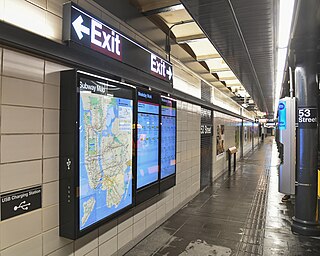
Since the late 20th century, the Metropolitan Transportation Authority has started several projects to maintain and improve the New York City Subway. Some of these projects, such as subway line automation, proposed platform screen doors, the FASTRACK maintenance program, and infrastructural improvements proposed in 2015–2019 Capital Program, contribute toward improving the system's efficiency. Others, such as train-arrival "countdown clocks", "Help Point" station intercoms, "On the Go! Travel Station" passenger kiosks, wireless and cellular network connections in stations, MetroCard fare payment alternatives, and digital ads, are meant to benefit individual passengers. Yet others, including the various methods of subway construction, do not directly impact the passenger interface, but are used to make subway operations efficient.

The Second Avenue Subway, a New York City Subway line that runs under Second Avenue on the East Side of Manhattan, has been proposed since 1920; the first phase of the line did not open until 2017. Up until the 1960s, many distinct plans for the Second Avenue subway line were never carried out, though small segments were built in the 1970s. The complex reasons for these delays are why the line has been called "the line that time forgot".

The Second Avenue Subway, a New York City Subway line that runs under Second Avenue on the East Side of Manhattan, has been proposed since 1920. The first phase of the line, consisting of three stations on the Upper East Side, started construction in 2007 and opened in 2017, ninety-seven years after the route was first proposed. Up until the 1960s, many distinct plans for the Second Avenue subway line were never carried out, though small segments were built in the 1970s as part of the Program for Action. The complex reasons for these delays are why the line is sometimes called "the line that time forgot".
